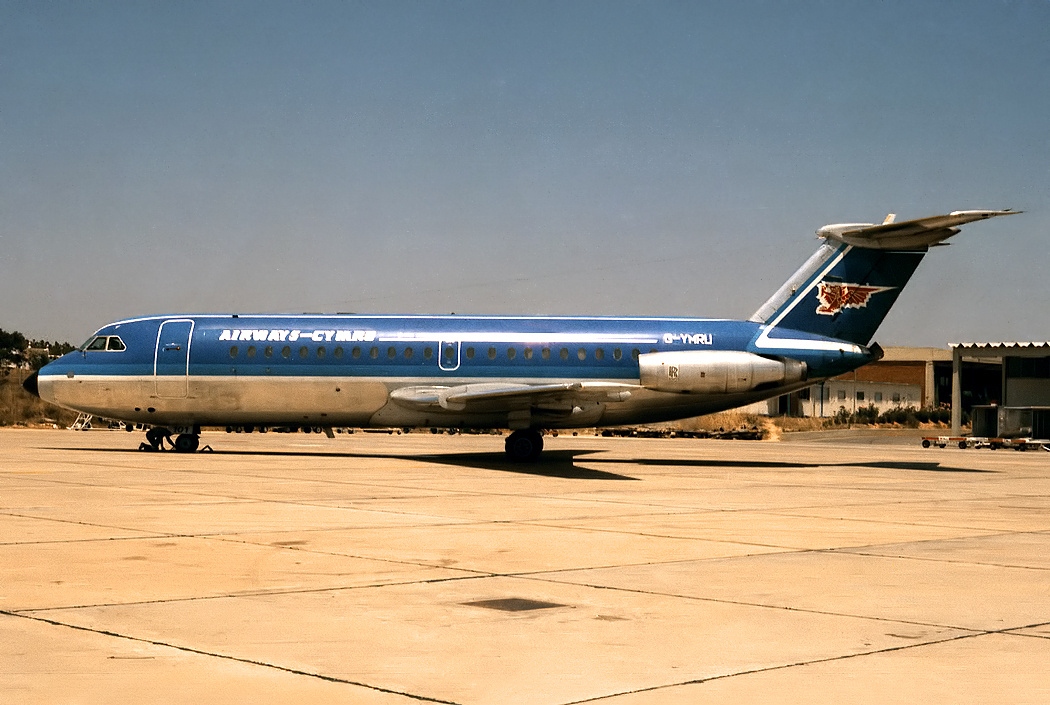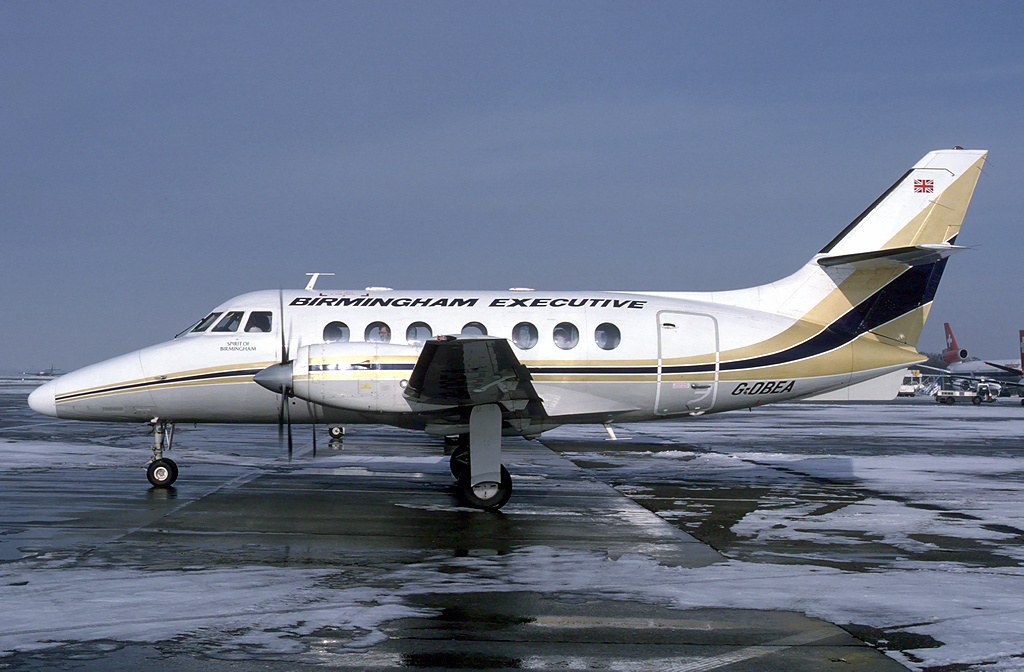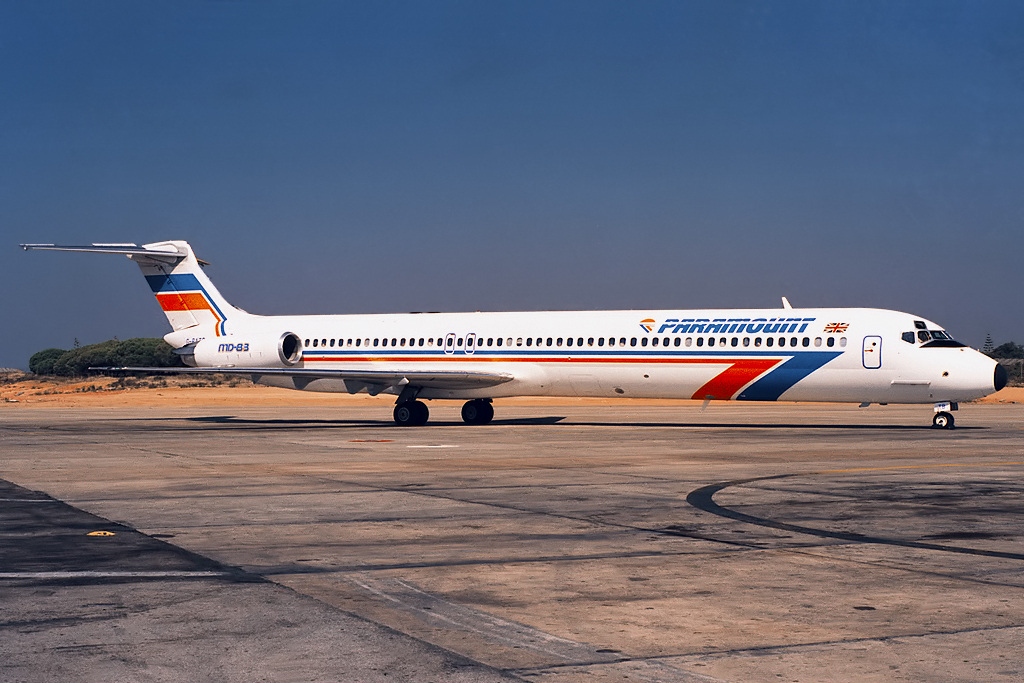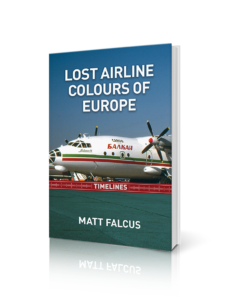Julia Prior takes a look at 11 UK airlines from the past.
How many of them do you remember seeing or flying on? Leave a comment below.
British Midland Airways

Can be traced back to 1938, with the formation of Air Schools Limited, specialising in flight training. Derby Aviation became the parent company in 1946, with a passenger carrying licence awarded in 1953. It was renamed Derby Airways in 1959. Another change came in 1964, with the acquisition of Manchester-based Mercury Airways. The newly completed East Midlands Airport became its home base, the British Midland name introduced in 1968. Former Mercury Ground Handling Manager, Michael Bishop was appointed General Manager. In 1970 it became the first independent carrier to employ UK based non-White cabin crew.
The Vickers Viscount was chosen to operate UK domestic and European routes, followed by entry into the jet age with the arrival of the Douglas DC9 and B707, the latter often leased to companies in West Africa until 1981, when BMA used them on UK holiday charters to the Mediterranean.
After leading a management buy-out in 1978, Michael Bishop was appointed Chairman. The fleet also changed over many years. BMA was launch customer of the BAe ATP utilised for off-peak flights and BHX-LHR feeder service, replacing the Fokker F27. With the arrival of the Boeing 737, Fokker 70 and 100, they replaced the DC9s. Another switch saw the introduction of Airbus A320/321 and Embraer ERJ135/E145.
The name disappeared in 2001, changing to BMI and A330s were added for long-haul operations. In 2008, Lufthansa bought Sir Michael Bishop’s shares to gain a majority holding. The full name, British Midland International, was reintroduced in 2010. After mounting losses, the company was sold to IAG in 2011. Its venture into the low-cost market with BMI Baby folded, as did the management buy-out operating as BMI Regional.
British Eagle

(c) BAe Systems
The airline flew from 1948 until its liquidation in 1968. Operated scheduled and charter flights on domestic, international and transatlantic routes. The initial fleet of two converted wartime bombers carried fruit and vegetables. In 1953, Eagle Airways’ first passenger flight from London Blackbushe to Belgrade via Munich used the Vickers Viking. With the acquisition of Sir Henry Lunn’s travel agency and Polytechnic Touring Association in the 1950s, it’s believed Eagle became the first airline to be integrated into a tour operator, Lunn Poly. In 1957, Eagle Airways Bermuda was formed in readiness for transatlantic flights. When Blackbushe closed, the company moved to Heathrow.
After Cunard purchased a major shareholding, the name was changed to Cunard Eagle Airways. Jets now entered the fleet in the form of Boeing 707s supporting the Bristol Britannia which had replaced the DC-6. After BOAC-Cunard’s formation, the company was renamed British Eagle International Airlines, utilising Britannia and Viscount, then B707 and BAC 1-11. Various attempts were made by competitors to shut down operations, especially British United who felt their jet services from Gatwick would suffer. Transatlantic plans met with objections from their main competitors. Devaluation of sterling and limits on foreign currency taken abroad heralded further problems. When the company ceased trading, its route network and aircraft were snapped up by carriers including Dan-Air, BUA, BEA and Laker.
Cambrian Airways

Founded in 1935 as Cambrian Air Services, a cargo airline based at Pengam Moors Airfield to the east of Cardiff. Restarting after WWII, the first airline to resume flights. From 1948, Cambrian began its cooperation with British European Airways (BEA). The Vickers Viscount first operated in February 1963 from Cardiff to Dublin via Bristol and flights commenced between Birmingham and Jersey. In 1964, the company operated to a few European leisure destinations. The BAC 1-11 was used on charter work and some scheduled routes. In 1967, BEA took over Cambrian although it still traded as a separate entity until incorporation into British Air Services. According to their November 1971 timetable, its scheduled network included many UK airports, two in the Irish Republic and Paris Le Bourget using four BAC 1-11 and eight Vickers Viscount. Then in 1974, it was one of the four component companies to form British Airways. The aircraft were painted in BA colours, with Cambrian in a much smaller text. The name disappeared totally in 1976.
British United (BUA)

Photo (c) Ralf Manteufel
The UK’s largest wholly independent airline; formed in 1960 by the merger of Airwork Services and Hunting-Clan Air Transport. The new company inherited a fleet of over 90 mixed aircraft and helicopters. London Gatwick was its operational hub, although some trooping flights continued from London Stansted until 1964. An order for ten BAC 1-11 jets placed in 1961 was the first for the type by a UK private airline. Due to restrictions on flying London-Paris direct, a rail-air concept was launched with flights from Lympne to Beauvais. Car ferry services commenced using the Carvair aircraft. BUA also took over some of BOAC’s services to South America, using the Vickers VC10. After company reorganisation and with these routes now making money, BUA became the UK’s only profitable mainline scheduled domestic operator.
Freddie Laker, BUA’s first Managing Director, used his many business contacts to establish a check-in centre in London’s West End, close to Victoria Station. He also personally negotiated orders for Trident aircraft and further VC10s. Not long after Laker’s departure in 1965, losses began to accumulate due to high aircraft depreciation charges, falling revenue on South American routes and fluctuating fortunes on UK-Germany trooping services. Subsequent reorganisation for a return to profitability was hampered by objections to BUA’s ambitious expansion plans to make it the “Second Force” airline, to complement or compete with BOAC and BEA. BOAC submitted a bid to take over BUA, rejected by the British Government. Caledonian stepped in and acquired the company in November 1970. Initially known as Caledonian/BUA, before becoming British Caledonian.
Airways International Cymru

Founded in 1984 by Red Dragon Travel, a leading Welsh travel agency and tour operator at that time. Operated flights from its Cardiff base to popular European holiday resorts initially using BAC 1-11 aircraft. The lack of galley ovens meant only cold food was served. Expansion plans saw the arrival of both new and used Boeing 737s to operate new tour operator contracts from most UK airports. The McDonnell Douglas MD-80 had also been considered, but Cardiff lacked the necessary engineering facilities.
During the quieter winter months, various aircraft were leased to other airlines. An American airline failing to make lease payments on a B737 led to financial difficulties. After an unsuccessful attempt to repossess the aircraft, the airline closed in early 1988 after their remaining fleet was impounded.
Air Europe

Photo (c) al-airlines.be
Another example of a travel agent/tour operator forming its own airline. Air Europe was part of the Intasun Group founded by entrepreneur Harry Goodman and two former Dan-Air executives. Latterly renamed International Leisure Group (ILG). Commenced operations in May 1979 from London Gatwick with brand-new Boeing 737-200s. With sustained growth in the 1980s it became the second largest tour operator behind Thomson. Further growth saw investment in Boeing 757s and setting up smaller satellite companies in Europe through acquisitions. The airline was perceived as “no frills” due to the high number of midweek and night flights. As the first holiday carrier to operate brand-new aircraft, Air Europe wanted its passengers to enjoy good quality food and service closely aligned to the scheduled carriers. New bases opened at Manchester and Cardiff.
Following ETOPS regulations introduced in the mid-1980s, Air Europe wanted to be the first British charter airline to operate the larger B757 on transatlantic routes. However, the CAA rejected their application which would have competed with BA and Pan Am from Heathrow, and Laker Airways from Gatwick.
Minimal success was recorded on the European scheduled operations it introduced, as destinations were already served by their charter flights. A fleet renewal programme studied the Rolls Royce powered McDonnell Douglas MD-11 and Airbus A320-200. In May 1986, ILG launched an unsuccessful bid for British Caledonian, also starting a concerted campaign to see off rival Dan-Air. The company folded in 1991, falling victim to the high cost of borrowing. Only Air Europa and Air Europe Italy survived. All aircraft in the fleet had out of sequence registrations, recognising the initials of key company personnel. Some also carried the forenames of their wives and children.
Court Line

Court Line L1011 (c) Ralf Manteufel
Founded in 1957 as Argus Air Transport, before becoming Autair, then Court Line in 1970. The airline’s home base was Luton, and Clarksons Holidays its most important tour operator customer. A new trendy look was introduced, to focus on the fast-growing package holiday market. Adopting the strategy that a holiday began with the flight, the fleet of BAC 1-11s was painted in pastel colours, comprising four distinct pallets. The colour scheme extended to subsequent L-1011 TriStars. Female cabin crew wore uniforms designed by Mary Quant in the same pastel colours. The airline also pioneered seat back catering. Typically, the food in a box attached to the seat in front was spam salad outbound and spam sandwiches on the return. The return box was locked, although some dexterous passengers managed to prise them open! Freeing up galley space generated room for three more seats.
In 1972, Court Line acquired Leeward Islands Air Transport (LIAT) and donated a BAC 1-11; the only jet ever operated on their flights around the Caribbean. The worsening economic situation of the early 1970s saw mounting losses. The acquisition of Clarksons did little to stem the flow. When the company collapsed in 1974, passengers were repatriated via the Tour Operators Study Group bond deposited by Court Line.
Orion Airways

Another airline formed to complement a tour operator, established in 1978 to carry Horizon Midlands customers to Mediterranean resorts during a flight capacity shortage. The travel company’s offices were located in Five Ways, Birmingham whilst the airline’s base was East Midlands. A significant presence was also established at Birmingham.
The Boeing 737-200 fleet included the 737th B737 to come off the production line. On its customer’s behalf, Boeing fought off many approaches from other airlines to get their hands on this icon. The aircraft displayed special decals just below the flightdeck windows, whilst a plaque was displayed just inside the forward port door.
Orion quickly gained a reputation for punctuality, service and a distinctive look. Cabin crew dressed in chocolate brown, instead of the standard navy blue. The company was also responsible for opening Costa Almeria to tourists, particularly Mojacar where a street bears its name. During expansion, it undertook charter operations for other tour operators and introduced some scheduled services. Two Airbus A300B4s were added to the fleet. In 1987, Horizon and Orion were purchased by the brewing and hotel group Bass. In 1988, an offer was accepted from Thomson Travel Group, which resulted in Orion being absorbed into Britannia Airways, its base now relocated to Luton. Some aircraft were absorbed into Britannia’s fleet, the remainder disposed of.
Air Corbiere

Part of the Air Atlantique Group based in Jersey, before moving to Coventry in 1985. Between 1990 and 1994, passenger services were operated as Air Corbiere. The airline was named after the lighthouse located just off the Channel Island. The fleet consisted a Fairchild Metro and Cessna Caravan. Flights also stopped at Gloucester Staverton.
With no cabin crew, inflight service consisted of a cool box containing sandwiches, snacks and cold drinks. Safety briefings were carried out by the first officer. The name subsequently disappeared when a management buy-out saw the formation of Atlantic Airlines as an independent company.
Birmingham Executive

Started operations from Birmingham in 1983; the first destinations were Zurich, Copenhagen and Milan using Jetstream 31 aircraft. The company wanted to serve predominantly the business travel market. A Saab 340 introduced in 1985 spent more time “tech” than flying and was disposed of later that year. Leasing a Gulfstream 1 to replace the Saab, more of this type were operated in a 24-seat layout.
One Jetstream carried the registration G-WMCC, believed to be in recognition of West Midlands County Council. Their first jet was a BAC 1-11. Other destinations included Amsterdam, Oslo, Cork, Stuttgart, Newcastle and Belfast. The distinctive uniform of a wrap style skirt led to complaints that not only did cabin crew have to hold onto their hats at a windy airport, they also had to ensure they did not expose more leg than acceptable! The company underwent many name and ownership changes. It became Birmingham European Airways, created by the demerger of Brymon European Airways. Maersk Air UK (a BA franchise) then took over, and the fleet was updated to Boeing 737-500s and a Jetstream 41. After heavy losses, a management buy-out led to the formation of Duo Airways which ceased operations in 2004.
Paramount Airways

Launched in April 1987, with flights on behalf of UK tour operators to popular Mediterranean destinations. Bristol was its home base with services from Birmingham, Cardiff, Exeter, London Gatwick and Belfast International during the peak season.
Paramount’s fleet consisted four brand-new McDonnell Douglas MD-83s and four Boeing 737-200s. Some Cessna Citations formed Paramount Executive.
The stand-out feature was no smoking on all flights. Some passengers tested this out, with at least one diversion and many onboard threats. One aggrieved passenger, having been told by the captain that he would divert then offload her, took the matter further by writing to the CEO. She then protested to the media again that his reply was rude and arrogant because he suggested that she did not have “a God-given right to flout the rules”. The company folded in 1989 with debts of £11m. A fraud investigation then began into losses at another company with the same chairman.
Information courtesy of Wikipedia, British Midland Airways, Air Atlantique, Airline History, PPRuNe.org (crew forum)
Images courtesy of Pinterest, BAE Systems, Arpingstone, Ralf Manteufel, Wikimedia, al-airlines.be, Russavia, Wikipedia, Flickr
 Lost Airline Colours of Europe
Lost Airline Colours of Europe
This book is packed full of lost airline liveries from across Europe, including many UK carriers. See airlines that have disappeared, and colour schemes that are no longer flying.






6 comments
British United did not operate Lympne to Beauvais, that was Skyways. The BUA route to Paris was “The Silver Arrow” – train Victoria-Gatwick, BAC-111 Gatwick-Le Touquet, train Le Touquet-Paris. The 111 didn’t last long on this route and it was eventually downgraded to a leased BIA Herald before it was terminated.
As a young ‘spotter’ in the late 60’s, I remember sneaking into Southampton airport where the Cambrian viscounts used to visit. Also the BUA 1-11’s, they were so noisy going over my mums house. I say sneaked into Southampton(Eastleigh) as the then owners did not like young spotters around and we were forever being ejected, only to sneak in from another direction. Happy days
Great memories, flew on BMA Viscount, 1-11, A320, A321, DC-9, great airline and great grub.
BCAL 1-11, also BUA on the 1-11-200 and 500 and the VC-10, again great in flight service.
Br Eagle, great flights on Viscount 701 and the mighty Britannia and have kept all my in flight souvenirs too.
Did 100s of loadsheets for the above airlines as well….and yes, kept a few souvenir copies !
BCAL, Court Line, Britannia never forgotten but you forgot Dan Air!!
In 1965 I went on holiday to southern France with my parents, flying from Heathrow to Perpignan return with British Eagle. As we disembarked from the Britannia at Heathrow at the end of the holiday I remember noting the registration, which I think was G-ARKB. That was the start of my interest in aviation.
The first jet I flew on was a BUA 1-11 in 1968 and some years later I flew from East Midlands to Paris by BMA Viscount.
Happy memories of some great aircraft!
Great memories Andrew!